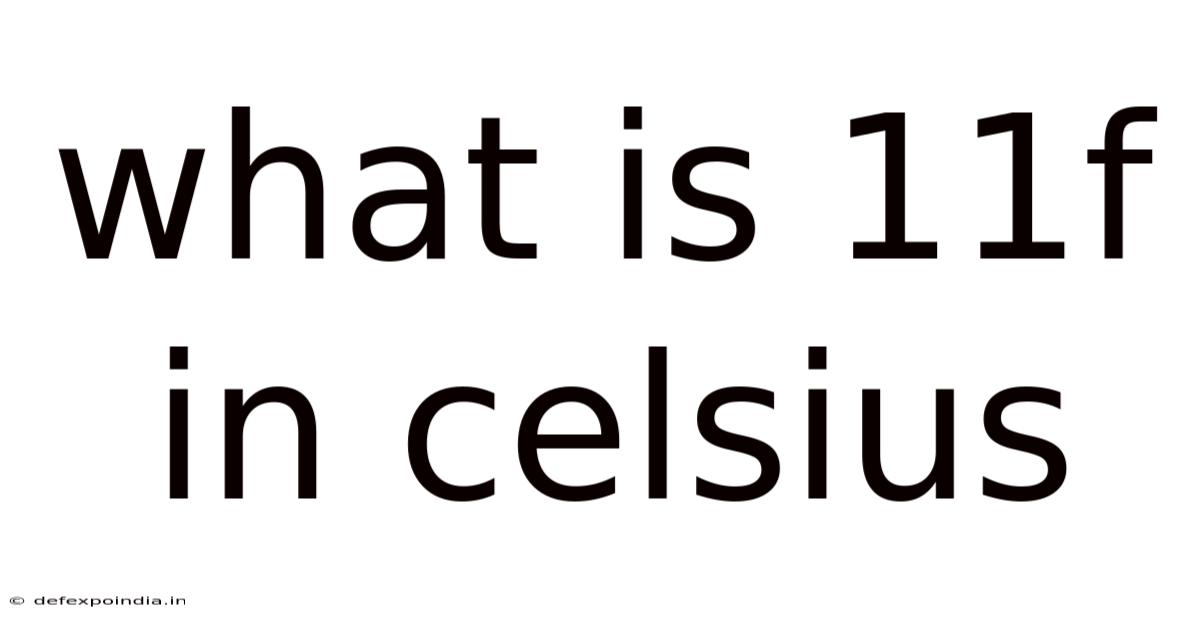What Is 11f In Celsius
defexpoindia
Sep 22, 2025 · 4 min read

Table of Contents
What is 11°F in Celsius? Understanding Temperature Conversions
Are you ever caught off guard by a temperature reading in Fahrenheit, especially when you're more accustomed to Celsius? This article will clearly explain how to convert 11°F to Celsius, providing a step-by-step guide and delving into the science behind the conversion process. We'll also explore some real-world applications of temperature conversion and answer frequently asked questions. Understanding temperature conversion is crucial for various purposes, from everyday life to scientific research, making this a valuable skill to possess.
Understanding Fahrenheit and Celsius
Before we dive into the conversion of 11°F to Celsius, let's briefly understand the two temperature scales. Both Fahrenheit (°F) and Celsius (°C) are scales used to measure temperature, but they have different starting points and increments.
-
Fahrenheit (°F): This scale was proposed by Daniel Gabriel Fahrenheit in 1724. The freezing point of water is 32°F, and the boiling point is 212°F, with 180 degrees separating them.
-
Celsius (°C): Also known as the centigrade scale, it was developed by Anders Celsius in 1742. The freezing point of water is 0°C, and the boiling point is 100°C, making the difference 100 degrees.
Converting 11°F to Celsius: A Step-by-Step Guide
The formula for converting Fahrenheit to Celsius is:
°C = (°F - 32) × 5/9
Let's apply this formula to convert 11°F:
-
Subtract 32 from the Fahrenheit temperature: 11°F - 32°F = -21°F
-
Multiply the result by 5/9: -21°F × 5/9 ≈ -11.67°C
Therefore, 11°F is approximately -11.67°C.
The Science Behind the Conversion
The conversion formula isn't arbitrary; it's based on the relationship between the Fahrenheit and Celsius scales. The formula is derived from the fact that there are 180 degrees between the freezing and boiling points of water in Fahrenheit and 100 degrees in Celsius. The ratio 5/9 reflects this difference. Subtracting 32 accounts for the difference in the freezing point of water (32°F vs 0°C).
The formula ensures a consistent and accurate conversion between the two scales, regardless of the temperature value. It's a linear transformation, meaning a constant change in Fahrenheit will result in a proportional change in Celsius.
Real-World Applications of Temperature Conversion
Understanding temperature conversion is vital in many fields:
-
Weather forecasting: Many countries use Celsius, while others use Fahrenheit. Conversion is essential for accurate interpretation of weather reports across different regions.
-
Cooking and baking: Recipes often specify temperatures in either Fahrenheit or Celsius. Conversion is crucial for successful cooking and baking outcomes.
-
Medicine: Body temperature is often measured in both scales. Accurate conversion ensures proper diagnosis and treatment.
-
Industry: Many industrial processes require precise temperature control, demanding accurate conversions between Fahrenheit and Celsius.
-
Science and research: Scientific experiments and data analysis often involve temperature readings that need conversion for accurate comparisons and analysis.
Beyond the Calculation: Understanding the Temperature
While knowing that 11°F is approximately -11.67°C is important, understanding the implications of this temperature is equally crucial. -11.67°C is a distinctly cold temperature. It's well below freezing point, indicating conditions suitable for ice formation and potential for frostbite if exposed for prolonged periods.
Frequently Asked Questions (FAQ)
Q1: Is there an easier way to convert Fahrenheit to Celsius?
A1: While the formula is straightforward, numerous online calculators and apps are available for quick conversions. These tools can save time and ensure accuracy.
Q2: Why are there two different temperature scales?
A2: Historically, different scales emerged independently, reflecting the prevailing scientific understanding and societal preferences at the time. Both scales remain in use due to historical reasons and regional preferences.
Q3: Can I convert Celsius to Fahrenheit?
A3: Absolutely! The reverse conversion formula is: °F = (°C × 9/5) + 32
Q4: What is the significance of the absolute zero point?
A4: Absolute zero, which is -273.15°C or -459.67°F, is the theoretically lowest possible temperature. At this point, all molecular motion ceases. It's a crucial concept in thermodynamics.
Q5: Are there other temperature scales besides Fahrenheit and Celsius?
A5: Yes, there's the Kelvin scale, which is widely used in scientific contexts. It's an absolute temperature scale, with 0 K representing absolute zero.
Conclusion: Mastering Temperature Conversions
Converting 11°F to Celsius highlights the importance of understanding different temperature scales and the conversion process. The formula provided allows for accurate conversion, and numerous online tools are available for quick calculation. Understanding the implications of this temperature, its real-world applications, and the science behind the conversion makes this seemingly simple calculation a valuable skill, applicable in various contexts from daily life to specialized fields. Therefore, mastering temperature conversions is not just about numbers; it’s about understanding the world around us better.
Latest Posts
Related Post
Thank you for visiting our website which covers about What Is 11f In Celsius . We hope the information provided has been useful to you. Feel free to contact us if you have any questions or need further assistance. See you next time and don't miss to bookmark.